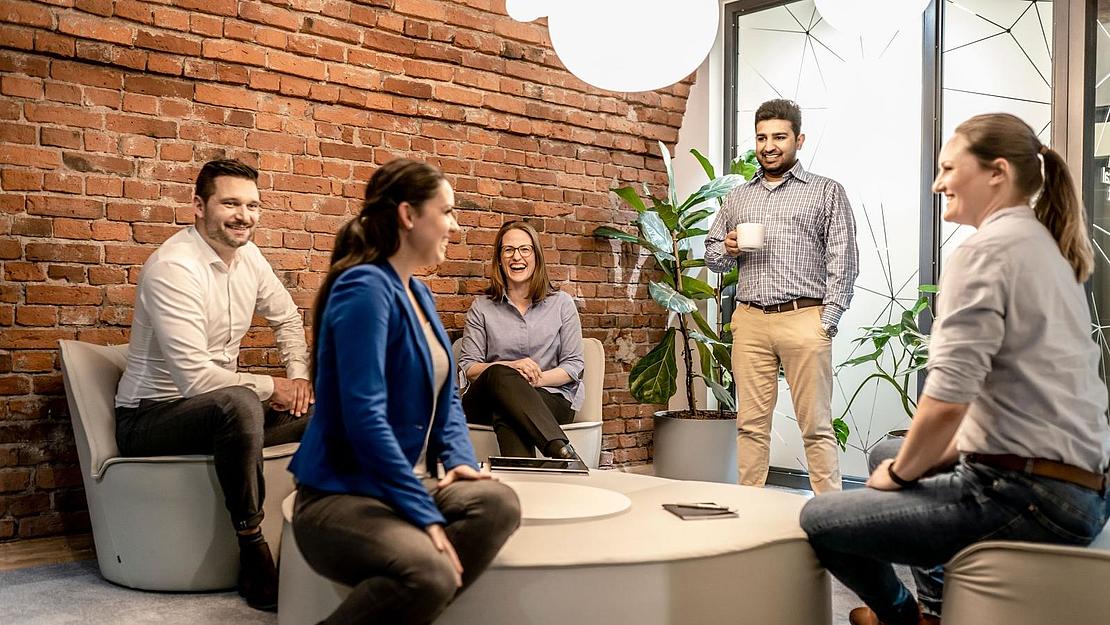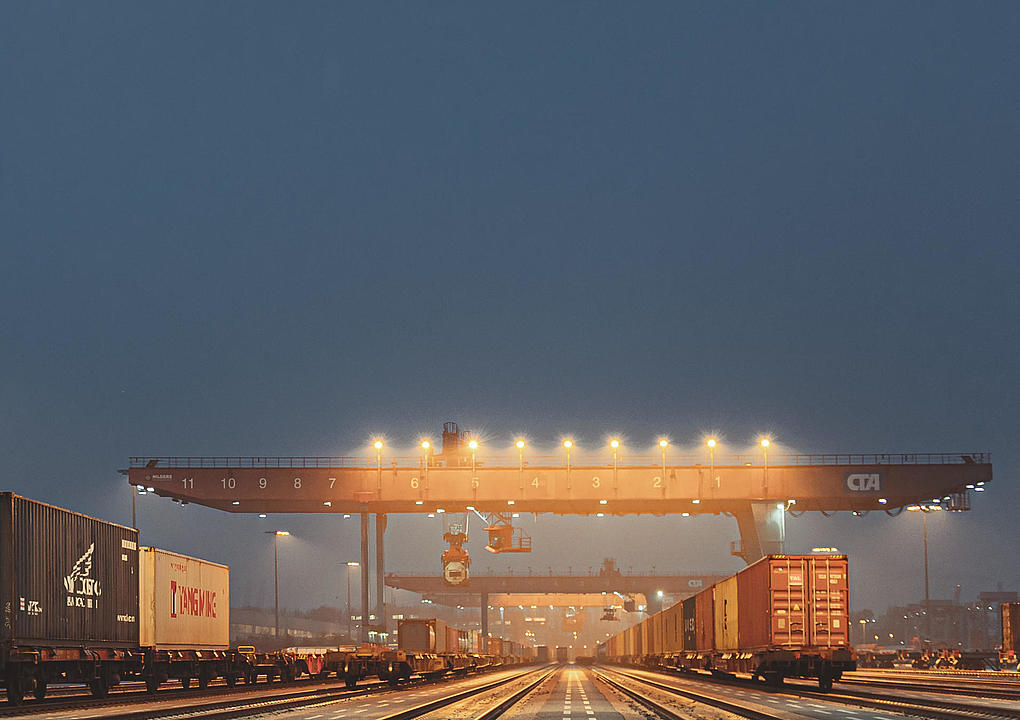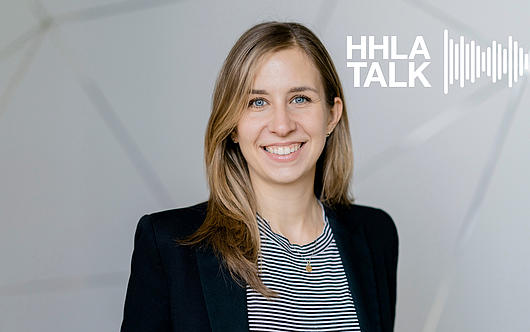
The HHLA Group has now had a very special subsidiary for one year. HHLA Next was founded for innovation and venture building, with a focus on digitalisation and sustainability in maritime logistics. To mark HHLA Next’s first birthday, we invited Managing Director Simone Lode to an HHLA Talk. She talks to us about deal flows, the right to play and the perfect fit. But don’t worry if that all sounds unfamiliar. We will put it in simple terms and it all comes down to how good ideas can be turned into successful products and business models.

Simone Lode, Managing Director of HHLA Next, is visiting us and I would like to start off by congratulating you on the company’s first birthday!
Yes, we are delighted that we have been around for a year now. Thank you.
Within the HHLA Group, you’re quite an unusual subsidiary. What is your speciality, as it were?
Our specialities are derived from the HHLA corporate strategy. HHLA Next was founded as a unit for innovation and venture building, with a focus on digitalisation and sustainability in maritime logistics. And that’s precisely our aim: to use ideas to develop successful products and business models. We either develop them ourselves or we invest in interesting, innovative companies.
That’s a great summary straight away. If I understand it correctly, you are heavily involved with start-ups, then. How does a start-up actually differ from a normal company?
Well, a start-up is a company that has just been founded. And it’s characterised by the fact that it has an innovative business concept – i.e. that it fulfils a customer need in an innovative way, or brings a new technology to the market. So, a very new company – that’s why it’s called a start-up. We not only deal with start-ups but with all innovative companies, including more established ones that have been on the market for a longer period of time. We carefully analyse the global maritime logistics market and select the companies that are the right fit for us to work with.
Yes, you hinted at that. So, at some point there is a start-up and then the company grows. Is there a specific point at which you can say: “Now it’s a grown-up – like when it’s listed on the stock exchange?”
Yes, the aim of any start-up is to become a unicorn, i.e. to achieve the valuation threshold of €1 billion. But of course only very few of them manage that. The key distinguishing feature is actually in the length of time that the company has been observed on the market. How much market experience has it already had? How many customers are already on board? Is the company achieving the right levels of revenue and results? And how many rounds of financing has the company already been through? These are the criteria we can use to determine that.

“On the one hand, we look for companies that are a good fit and, on the other hand, we set up our own companies.”
So, in summary, you look for companies that are the right fit for HHLA.
That’s right. On the one hand, we look for companies that are a good fit and, on the other hand, we set up our own companies. And to do this, we have a team that continually monitors market trends, stays abreast of new technologies and, as I mentioned, keeps its eyes open for new companies around the world. We even maintain a database with this information. This database features the companies in various sectors, such as in the Supply Chain, autonomous driving or automated handling. Are there then different categories into which the companies can be sorted if they are of interest to us? And we then monitor them continually. At the right time, we contact the company in order to initiate investments, for example.
So what are the megatrends at the moment? You’ve named a few examples, but which are the main ones from your perspective?
Well, I think supply chain disruption has been a big topic for a few years now. As a result, that and supply chain transparency are really big issues.
So, tracking and tracing?
Yes, among other things. But also data transfer, for example. Across various interfaces, so within the supply chain, there are various players, such as shipping companies, terminals, operators, shipping agents, port agencies, etc. All of them have their data silos and lots of information gets lost there because it isn’t shared. Ships calling at the port are also a major factor for all subsequent downstream processes. So when does a transport company need to arrive at the terminal in order to pick up the containers? Or the truck drivers? When do they need to arrive at the terminal in order to pick up the containers? These are the sorts of topics we are focussing on and all with a view to increasing digitalisation and sustainability.
“Hamburg is making a name for itself as an attractive location for start-ups. And of course it’s got that maritime focus.”
It seems to me that Hamburg is the perfect place for this. After all, it is one of the biggest European logistics hubs. Is it the case that there is a particularly high number of interesting companies here?
Definitely. Hamburg is making a name for itself as an attractive location for start-ups. And of course it’s got that maritime focus. It’s for good reason that it’s home to Digital Hub Logistics, which is also based in Hamburg and is a partner we work together closely with. We do this so that we can raise our profile here in the start-up scene and expand our network. Maintaining better contacts with start-ups helps us to fill our deal flow, as it is called. And not just on the international stage but also here in Hamburg. This is where we’re from and where we feel at home.
Yes, and from the Speicherstadt historical warehouse district at that – a beautiful location. It’s not far from here that the Digital Hub Hamburg is opening its new offices.
That’s right, and we’re a little bit sad about it! At the moment, they’re just above us but then we’ll be a bit further apart. But the partnership is so strong that we are sure to be developing new business ideas together again before long.
“So the start-up doesn’t just benefit from our money but from our market access, our industry expertise and from our clients.”
So, are you currently looking around at companies? Do have any names on your lists or databases? What would be the perfect match, or perfect fit, for HHLA from your point of view?
Well, to give you an idea: We looked at over 2,000 companies in the past year alone. We have short-listed 700 in our database. But the perfect fit is hard to find. It needs to be a good match for HHLA’s strategy. Which means championing digitalisation and sustainability. At HHLA, we have a strong focus on innovation. As a result, it needs to have an innovative business concept. And then it also has to serve a market segment that is set to experience high rates of growth in the future, too. We refer to this as market appeal and market growth. And of course we at HHLA also need to be able to contribute our knowledge. So the start-up doesn’t just benefit from our money but from our market access, our industry expertise and from our clients. We also want to provide the right support as HHLA. As a result, we also ensure that HHLA has a right to play.
Climate neutral by 2040
By implementing its balanced logistics strategy, HHLA brings ecological, social and economic responsibility into harmony.
Can you explain that again, please? Right to play …?
Of course. So, does HHLA have a say in the company? And what added value can HHLA bring to the company in question?
So, we’re not just looking at investments in order to make profits. It’s not just that, although of course that plays a role, no? Or is that not so much of a factor in the new economy, achieving profit at some point?
Well, making money is of course the ultimate endpoint, we have a clear assignment to make a profit. We aim to develop a new strategic sector for HHLA and that includes achieving revenue and profit. But, and this is what sets us apart from venture capitalists, we don’t focus on short-term maximisation of profits – instead, we strive for a strategic partnership. This means that we don’t just sell all of our shares when the start-up reaches its highest valuation price. Instead, we aim to create long-term partnerships and truly strategic partnerships.
“The investment is primarily in the team, the team of founders, the core staff. Next comes the business idea and all the other criteria I mentioned.”
Yes, you have already described a bit about what happens next. Once you’ve found a company or a founder approaches you, you conduct some initial meetings. Can you maybe explain using an example what entrepreneurs can expect when they approach HHLA?
I would like to go back a moment to the question before. So, something else that is another aspect of that perfect fit. And it’s what you just mentioned. Along with the founder, the team within the company is enormously important. The investment is primarily in the team, the team of founders, the core staff. Next comes the business idea and all the other criteria I mentioned. That means they really have to be passionate about it. They need to show a high level of professionalism, know what they’re talking about and their company needs to meet a customer need. That can be seen in the market penetration and the customer orders that they acquire.
I can’t quite get my head around that. The team is made up of people and there wouldn’t generally be any information about them in the database. How can you tell if it’s a good team?
That’s why we have our meetings. We get to know the founders very well. We meet them in person, we go to their offices and get into some good discussions with them. We also want to meet the team. And that can’t be done on paper or in the database – you need to actually go and maintain the in-person contact. And we do that very intensively.
OK, I’ve got it now. But what exactly is the next step?
Well, once we’ve checked off our list of criteria and everything has the green light, we would submit the company to some more in-depth checks. In M&A jargon, that’s known as due diligence. We look at the various areas of the company in detail – commercial areas, financial areas, technical areas and, of course, legal areas, fiscal areas and really give the company the once over. And if there are no good reasons indicating that we shouldn’t invest then we hopefully come to a positive investment decision.
There are several successful start-ups in the logistics industry already. They’re just not quite as well-known as in other industries. Which companies in our sector would you name if I were to ask you about successful start-ups?
We have invested indirectly in one that I find very, very interesting and successful. They’re called Motion Ventures Fonds – that is to say, HHLA Digital Next also invests in funds. And these funds then also invest in start-ups. Motion Ventures Fonds invests in Harbour Lab. That’s a Greek company, from Athens. And it meets all of these criteria. Active in maritime logistics, champions digitalisation, is a digital platform, links various players in the maritime logistics industry and clearly addresses a customer problem, which is creating the right kind of interface between shipping companies and port authorities. And they are so successful and recognised this problem so clearly. They have plenty of market expertise and a whole lot of passion. The team of founders is so great that they already achieved high valuations in their recent round of financing. We were lucky to even get on board with Motion Ventures Fonds because the round of financing was completely oversubscribed, as we say. Sorry for all these technical terms!
“We use funds so that we can get involved with investments at a very early stage.”
So they were completely sold out – we just managed to sneak in there in time. So investments in funds are another tool that you use in order to become involved with potentially innovative, or already innovative, companies?
That’s right. We use funds so that we can get involved with investments at a very early stage. Companies that haven’t been on the market for very long are also associated with a higher risk of potential failure. Investment funds are, in our opinion, the safer alternative there because the large portfolio covered by the fund means that the risk of failure is lower than if we were to invest directly. And if we invest directly, they tend to be higher investments at a later point.
That all sounds like a lot of work: Research, conducting meetings and all the preparations. But there’s another aspect to your work and that’s setting up your own corporate ventures as spin-offs. I read that when preparing for this talk but didn’t quite understand it.
That’s right. We also work on generating our own innovative ideas. We have more than 6,300 clever and creative people at HHLA and these people have a deep understanding of the industry and of the port. Of course we also try to promote this and to generate innovative ideas. That’s why we’ve set up an innovation process where ideas can be contributed and we address them and develop them. There are various phases in this innovation process. After all this analytical work, one phase is to develop what is known as an MVP. We’re back to the jargon again, I’m afraid. MVP stands for minimum viable product – a product that can be tested to see if there is really a demand for it on the market.
Rethink. Think further. Think ahead.
Megatrends and our new business areas Automation, Artificial intelligence, Interconnected supply chains, Drone technology and Hydrogen
A kind of prototype, then?
Exactly. But a bit more than a prototype. And if that all goes well, this customer field test, then we would also establish our own company as a spin-off. We would have to set up a team of founders to manage it and build up the company.
Ventures such as these don’t come from nowhere. Are you like a kind of greenhouse to encourage their growth?
Yes, you could put it like that. Exactly. We try to provide the conditions in which these delicate little seedlings can flourish. That means we support them with venture-building expertise on the one hand. We have lots of colleagues that not only have major project expertise, exceptional digital expertise, sometimes even coming from the software development side themselves, but also have this industry expertise. Because that’s absolutely vital. That’s at the heart of it all. And, when things go well, this interplay of industry expertise and project and venture-building expertise can result in great ideas and successful ventures. We shore all of this up with auxiliary services, such as finance and financial controlling, support – but also strategic support – marketing and communication. Those are the main areas.
“HHLA never stood still – otherwise it wouldn’t be around any more.”
Let’s turn back to the start-ups for a minute. They tend to be characterised by a particular kind of culture. Is this culture something you can find at HHLA, or is it something that needs to be cultivated?
Yes, creating the culture is difficult, of course. But HHLA has been a start-up for a very, very long time and is driven by its innovative prowess. We can see that in many areas of our operating business. HHLA never stood still – otherwise it wouldn’t be around any more. This resulted in a very innovative culture and the desire to create something new. And we try to leverage this at HHLA Next so that we can transfer it into our new ventures. But of course they also have to develop their own culture. Spin-offs are independent companies and should have their own identities and thus develop their own cultures.
You have helped to guide some of them already, haven’t you? Well, some of them were founded before you had even been founded. But which are the HHLA companies that are part of your portfolio?
The HHLA Next portfolio includes iSAM …
Let’s just elaborate there: What does iSAM do?
Automated handling technology, particularly in the area of bulk cargo. But also with the world’s first fully automated rail gantry crane. So truly a worldwide hidden champion, as we say. And the rail gantry crane, that will operate here in Hamburg at the CTA. We’re very proud of that. So iSAM is a mature company in the portfolio.

Human and machine: Interacting, not competing
Their sheer size makes seaports a great option for automation. What are the reasons for and the limits of this process?
Yes, and HHLA Sky has also made a name for itself.
Yes, it’s really very well established. It developed the first platform for the coordination of drone flights, so automated drones. They can be flown all over the world via a control centre. It’s super innovative and can of course also be transferred to other areas, so to any mobile robotics applications you can imagine.
Yes, who else? Modility has also shown great progress too, right? But first of all we should explain what Modility is.
Modility is our booking.com for multi-modal traffic – a platform that brings together supply and demand. This can help get goods travelling by rail, which also saves CO2 because they no longer have to travel by road. Modility has also performed very well and I am confident that this will continue to be the case.
“Soon, Heyport will also be operating as an independent company, as a port coordination platform.”
Yes, I’ve already tried it out for myself. It’s really great. Just a few clicks, which is exactly what you want from an online platform. Well, I guess we’re nearing the end now. We’ve summarised a bit now. Can you tell us some of your thoughts for the future? Anything to divulge there? Who will be entering the market next?
Well, that’s one secret I’m happy to share with you! We are very proud to have brought Heyport to market. Soon, Heyport will also be operating as an independent company, as a port coordination platform. This means that Heyport will coordinate ship calls in ports around the world, making it interesting to both terminal operators and shipping companies alike. Those are the customers and they will be able to see very clearly from this platform when which ship will be arriving and which quayside it will be docking at. How long will it be there for, and are there any risks of clashes during its stay? Not clashes in the sense of collisions, but in the sense of certain quays being overbooked. The ship’s agents or terminal operators can see that and coordinate accordingly so that the ships arrive in the port on schedule.
So, the aim is to offer Heyport to a whole range of ports? Not like our subsidiary HVCC here in Hamburg, which was the first to develop a leading software solution for such approaches into the Port of Hamburg. You take a bit more of a global approach?
Exactly – we always think globally! And, in the first step we are focussing on bringing Heyport to small and medium-sized ports and terminal operators because the manual effort involved in coordination is so much greater. They often don’t have any systems at all for recording their ship coordination but sometimes still organise everything with sticky notes on a wall, for example, or with Excel tables. Lots of them are always making calls and writing loads of emails, which results in a huge amount of manual work. A platform like this that can take care of the coordination and the communication is worth its weight in gold.
But for seaports – not yet for inland ports?
That could be the next step in the process. What is relevant at the quayside is also just as relevant for the railways. And that is exactly what we’re thinking about at the moment.
Yes, we are really thinking ahead to the future here. Simone, I think we will need to catch up again later at some point! I’m sure by then even more progress will have been made. But after just one year, you’ve already achieved a lot. Thanks for talking to me today!
For more information about HHLA Next and your contact partners
Published in November 2022

Sign up for HHLA Update and explore the changes in the logistics world!
Sign up for HHLA Update and explore the changes in the logistics world!
Sign up

